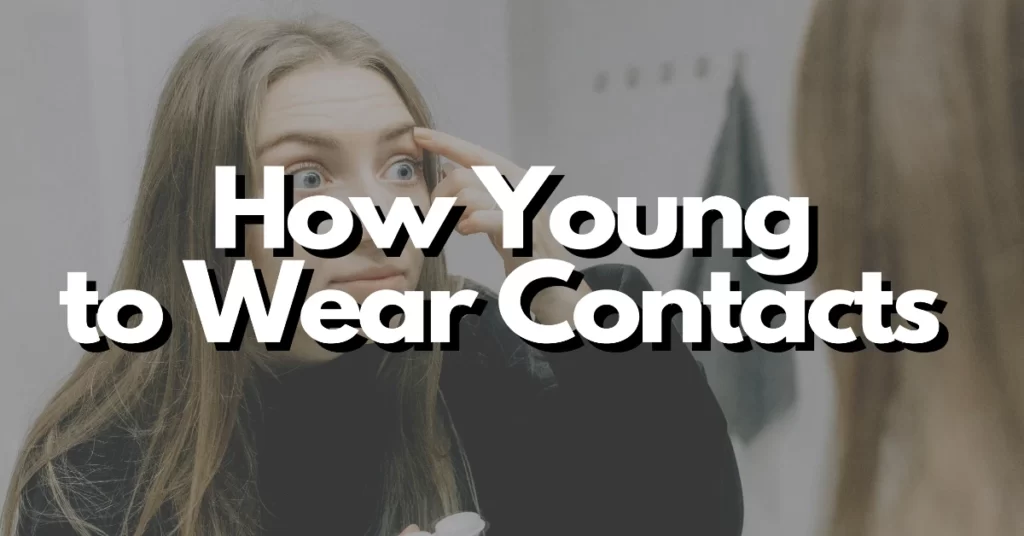Contact lenses have become a popular vision correction option for people of all ages, including children and teenagers. While many parents may have reservations about their child wearing contact lenses, it’s essential to understand that modern contact lenses are safe and can offer various benefits for young wearers.
In this article, we will delve into the world of children and contact lenses, addressing important topics such as the minimum age for contact lenses, the role of parental consent, challenges young wearers may face, and the potential benefits.
Recommended Age for Children
One of the first questions parents often ask is, “At what age can my child start wearing contact lenses?” The answer to this question is not solely determined by a specific age but rather depends on various factors, including the child’s maturity, responsibility, and motivation to wear contact lenses. While some children may be ready for contact lenses at a relatively young age, others may need more time to adapt.
Parental Consent
Parental consent and involvement in the decision to have your child wear contact lenses are crucial. Even if your child is enthusiastic about making the switch from glasses to contacts, their eye care should always be a collaborative effort between parents, children, and eye care professionals. Parents are often in the best position to evaluate whether their child is ready for the responsibility of contact lens wear.
Challenges for Young Contact Lens Wearers
Adaptation Period
The transition from eyeglasses to contact lenses can be both exciting and challenging for children. During the initial adaptation period, young contact lens wearers may experience a learning curve. They will need to become proficient in inserting and removing their lenses, maintaining proper hygiene, and following a prescribed wearing schedule.
It’s essential to be patient and supportive during this adjustment phase, as it can take some time for your child to become comfortable with contact lenses.
Responsibility
One of the key challenges for young contact lens wearers is the need for responsibility. Unlike glasses, which require minimal maintenance, contact lenses demand a higher level of care. Stressing the importance of proper lens care, including cleaning, disinfecting, and storing, is essential.
Additionally, young wearers must adhere to their eye care professional’s recommended wearing schedule and replace lenses as directed to ensure optimal eye health.
Effect on Eye Development and Vision
Eye Development in Children
Parents often wonder whether contact lens wear can affect the ongoing development of their child’s eyes. Fortunately, contact lenses are designed with the utmost consideration for eye health. Modern contact lens materials allow for the flow of oxygen to the cornea, ensuring that the eyes receive the necessary nutrients and oxygen for healthy development.
Vision Development
Parents may also be concerned about the impact of contact lenses on their child’s vision development. Contact lenses do not inherently influence vision development in a negative way. In fact, they can provide children with clear and consistent vision, which can be particularly advantageous for academic and extracurricular activities.
Benefits of Contact Lenses for Kids
Sports and Activities
One significant advantage of contact lenses for children is their suitability for sports and active lifestyles. Unlike glasses, contact lenses do not interfere with peripheral vision, and they don’t fog up or slide down the nose during physical activities. This freedom of movement can boost a child’s performance in sports and enhance their overall experience.
Self-Esteem and Confidence
Some children may feel self-conscious about wearing glasses, which can affect their self-esteem and confidence. Contact lenses provide an alternative that can help children feel more comfortable and confident in their appearance. This boost in self-esteem can have a positive impact on their social interactions and overall well-being.
Choosing the Right Contact Lenses
Types of Contact Lenses
When considering contact lenses for your child, it’s essential to explore the different types available. Daily disposable contact lenses are often a popular choice for children. These lenses are designed for single-use, eliminating the need for cleaning and disinfection. They are convenient, hygienic, and reduce the risk of eye infections.
Rigid Gas Permeable (RGP) Lenses
In some cases, children with specific vision issues, such as astigmatism, may benefit from rigid gas permeable (RGP) lenses. These lenses provide sharp vision and are highly durable. While they may require a more extended adaptation period due to their rigid nature, they can be an excellent option for children with certain eye conditions.
Tips for Parents
Educational Resources
To ensure a smooth transition to contact lenses, parents can take advantage of educational resources. Many eye care professionals offer training sessions for both parents and children to learn how to insert, remove, and care for contact lenses properly. These resources can enhance your child’s confidence and competence in lens wear.
Eye Care Professional Guidance
The guidance of an eye care professional is invaluable when it comes to children and contact lenses. They will assess your child’s eye health, determine the appropriate lens prescription, and provide comprehensive instructions on lens care and hygiene. Regular eye exams are essential to monitor your child’s eye health and the condition of their contact lenses.
Conclusion
Choosing contact lenses for your child is a decision that should be made thoughtfully, in consultation with an eye care professional. When the transition is handled responsibly and with proper guidance, contact lenses can provide children with clear vision, boost their self-esteem, and enhance their overall quality of life.
The key is to ensure that both parents and children are educated about the responsibilities that come with contact lens wear and to prioritize regular eye care check-ups to safeguard their eye health.
